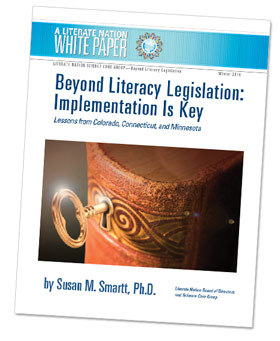Literacy Legislation

Susan Smartt has written a white paper summarizing three recently passed literacy laws designed to improve overall literacy outcomes for students in their states. The states are Colorado, Connecticut, and Minnesota.
Most people I meet who are not educators are surprised to learn that only about a third of America’s students read at a proficient level or above (NAEP Reading Scores). Susan’s report reviews the details of the process these states went through to pass legislation and support implementation of these literacy laws. Building improved knowledge about effective literacy instruction is a key element in all three laws, as is a focus on early reading instruction to try and catch young children before they experience failure. Unfortunately, as the report notes, passing legislation is not sufficient to make a difference – consistency in implementation of literacy laws is what’s needed.
The white paper was published by Literate Nation, an organization that I have mentioned in a previous blog post. This non-profit organization is dedicated to supporting grass-roots, local movements that promote awareness of the literacy needs of students. Its Grassroots Leadership Guide was designed to support individuals who are interested in starting “literacy movements” in their state, including how to promote literacy legislation similar to the laws passed in Colorado, Connecticut, and Minnesota.
If you are interested in following federal legislation related to literacy and support for students who struggle in school, the Alliance for Excellent Education website has a Federal Legislation page that is regularly updated. The Alliance has long been a favorite of mine and I regularly recommend the site as an excellent resource for reports and fact sheets related to literacy, and especially adolescent literacy. This includes the seminal reports Reading Next, Writing Next, and Writing to Read.

 Joan Sedita is the founder of Keys to Literacy and author of the Keys to Literacy professional development programs. She is an experienced educator, nationally recognized speaker and teacher trainer. She has worked for over 35 years in the literacy education field and has presented to thousands of teachers and related professionals at schools, colleges, clinics, and professional conferences.
Joan Sedita is the founder of Keys to Literacy and author of the Keys to Literacy professional development programs. She is an experienced educator, nationally recognized speaker and teacher trainer. She has worked for over 35 years in the literacy education field and has presented to thousands of teachers and related professionals at schools, colleges, clinics, and professional conferences.
Leave a Reply